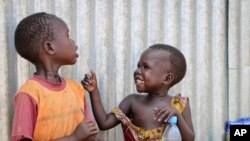U.N. Secretary-General Antonio Guterres said Tuesday he was "appalled" that more than 12,000 children were killed or maimed last year in some 20 countries at war or in a state of conflict.
The unprecedented level of violence against boys and girls was recorded in the U.N.'s annual report naming and shaming countries and armed groups that perpetrate such violence.
In all, the U.N. recorded 24,000 grave violations against children in 2018, including killing, maiming, sexual violence, abductions, recruitment and attacking schools and hospitals.
Worst offender
"But without a doubt, the one situation that really comes to my mind is the worst one — the one we have to do our utmost to reverse — is Somalia," said Virginia Gamba, U.N. special representative for children in armed conflict, whose office prepares the often-controversial report.
She told reporters that the number of violations across all categories there is very high, providing a worrying picture. She said there is also a lack of engagement with the United Nations to improve protections for children, and she said she hopes to visit Somalia in the next two months to see if there is any possibility to open a dialogue.
Both the Somali National Army and the terrorist group al-Shabab, as well as the Ahlu-Sunna Wal-Jama'a (ASWJ), were included in the report's annex of perpetrators.
Targeting hospitals and schools
One of the more troubling trends emerging in the 2018 report is the growing targeting of schools and hospitals from Yemen and Syria to Afghanistan and South Sudan.
"Here you can actually see the tactics of war, and we are seeing more and more armed groups on purpose destroying schools — and particularly those that engage in girls' education," Gamba said. "If you are destroying schools, you are destroying choices."
She noted that on a recent visit to Mali, she spoke with youth who told her of having no education or vocational opportunities, which means they will have few job prospects.
"It seems to me that there is every intention of armed groups to destroy the possibility of giving an alternative to children outside of war usage," she said.
Treading lightly with Saudi Arabia
In recent years, Saudi Arabia has rejected its listing for its role in the Yemen war, which has led to the report's annex being separated into two lists — one for grave violators and another for parties that are perpetrating violations but have put in place measures aimed at improving the safety of children.
Saudi Arabia is not listed by name in the 2018 report but rather as the "Coalition to Support Legitimacy in Yemen." It is not among the most grave violators, despite the report citing numerous airstrikes that killed or maimed 685 children last year.
The coalition, which has engaged with the U.N. on the issue, is among those parties that have put in place measures to protect children. The Houthi rebels who they are fighting are on the most serious offenders list.
"It's baffling that the secretary-general's 'not-so-bad' list gives credit to parties that are increasing, not reducing, their violations against children," said Human Rights Watch children's rights advocacy director, Jo Becker, in a statement. "Guterres should return to a single list based solely on evidence of violations on the ground."
Israel vs. Palestinians
Israel was not listed, despite the U.N. verifying the deaths of 57 Palestinian children — 56 were attributable to Israeli forces and one to an Israeli settler — the highest figures since 2014. The report also found that nearly 3,000 Palestinian children were injured during the Great March of Return in March and April of last year, when there were daily protests at the security fence separating the Gaza Strip from Israel.
Gamba said the secretary-general ultimately decides who is listed, and that he has directed her office to further examine the killings and maimings of children in the Palestinian territories and to report back to him by the end of December. She is also to look into the recruitment of children by Palestinian militants.
The special representative also noted that she has repeatedly sought to engage with both the Israeli and Palestinian authorities and has been unsuccessful, and hoped that the secretary-general's new directive would enable her access.
"My office was not born to name and shame and attribute, and that's it," Gamba said of the controversies her annual blacklist generates. "The job is to raise awareness on the plight of children and to try to prevent the violations and better protect children."




